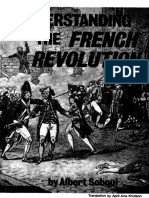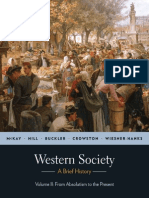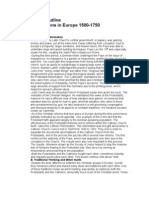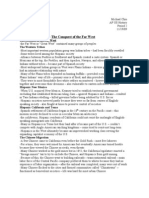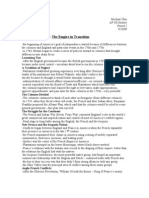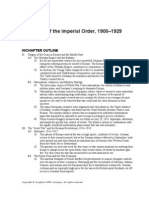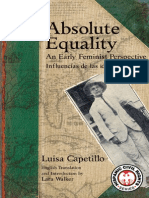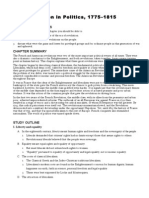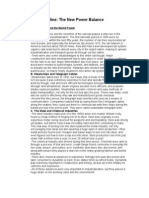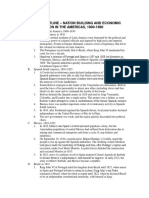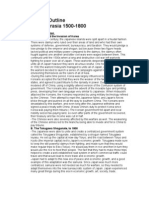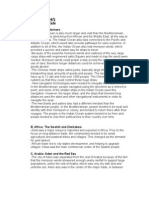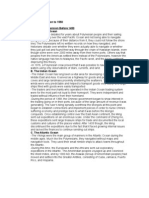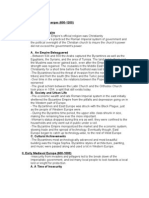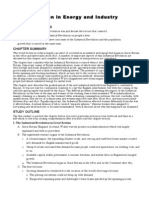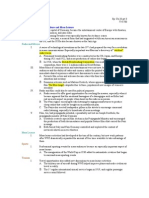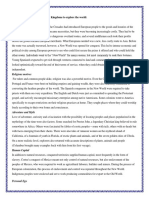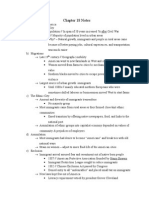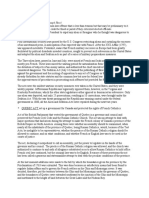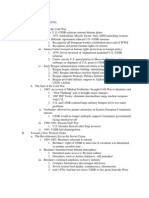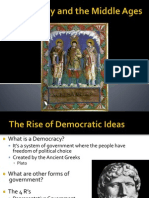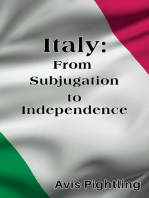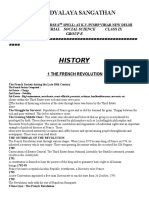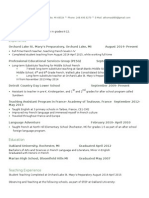Revolutionary Changes in The Atlantic World, 1750-1850: 0instructional Objectives
Revolutionary Changes in The Atlantic World, 1750-1850: 0instructional Objectives
Uploaded by
D.j. FanCopyright:
Available Formats
Revolutionary Changes in The Atlantic World, 1750-1850: 0instructional Objectives
Revolutionary Changes in The Atlantic World, 1750-1850: 0instructional Objectives
Uploaded by
D.j. FanOriginal Title
Copyright
Available Formats
Share this document
Did you find this document useful?
Is this content inappropriate?
Copyright:
Available Formats
Revolutionary Changes in The Atlantic World, 1750-1850: 0instructional Objectives
Revolutionary Changes in The Atlantic World, 1750-1850: 0instructional Objectives
Uploaded by
D.j. FanCopyright:
Available Formats
CHAPTER 21
Revolutionary Changes in the Atlantic World,
1750–1850
0INSTRUCTIONAL OBJECTIVES
After studying this chapter students should be able to:
10. Understand the economic and ideological causes of the American, the French, and the Haitian
Revolutions.
20. Discuss and compare the course of the American, the French, and the Haitian revolutions and
analyze the reasons for and significance of the different outcomes of these three revolutions.
30. Understand the successes and the shortcomings of the conservative reaction to the French
Revolution as seen in the actions of the Congress of Vienna and the Holy Alliance.
40. Describe the causes and results of agitation for the extension of democratic rights and national
self-determination in Europe and the United States of America in the nineteenth century up to
1870.
00CHAPTER OUTLINE
I0. Prelude to Revolution: The Eighteenth-Century Crisis
A0. Colonial Wars and Fiscal Crises
10. Rivalry among the European powers intensified in the early 1600s when the Dutch
attacked Spanish and Portuguese possessions in the Americas and in Asia. In the 1600s
and 1700s, the British then checked Dutch commercial and colonial ambitions and
went on to defeat France in the Seven Years War (1756–1763) and take over French
colonial possessions in the Americas and in India.
20. The unprecedented costs of the wars of the seventeenth and eighteenth centuries drove
European governments to seek new sources of revenue at a time when the intellectual
environment of the Enlightenment inspired people to question and to protest the state’s
attempts to introduce new ways of collecting revenue.
B0. The Enlightenment and the Old Order
10. The Enlightenment thinkers sought to apply the methods and questions of the
Scientific Revolution to the study of human society. One way of doing so was to
classify and systematize knowledge; another way was to search for natural laws that
were thought to underlie human affairs and to devise scientific techniques of
government and social regulation.
20. John Locke argued that governments were created to protect the people; he emphasized
the importance of individual rights. Jean Jacques Rousseau asserted that the will of the
people was sacred; he believed that people would act collectively on the basis of their
shared historical experience.
30. Not all Enlightenment thinkers were radicals or atheists. Many, like Voltaire, believed
that monarchs could be agents of change.
Copyright © Houghton Mifflin Company. All rights reserved.
152 Chapter 22: Revolutionary Changes in the Atlantic World, 1750–1850
40. Some members of the European nobility (e.g., Catherine the Great of Russia, Frederick
the Great of Prussia) patronized Enlightenment thinkers and used Enlightenment ideas
as they reformed their bureaucracies, legal systems, tax systems, and economies. At the
same time, these monarchs suppressed or banned radical ideas that promoted
republicanism or attacked religion.
50. Many of the major intellectuals of the Enlightenment communicated with each other
and with political leaders. Women were instrumental in the dissemination of their
ideas; purchasing and discussing the writings of the Enlightenment thinkers; and, in the
case of wealthy Parisian women, making their homes available for salons at which
Enlightenment thinkers gathered.
60. The new ideas of the Enlightenment were particularly attractive to the expanding
middle class in Europe and in the Western Hemisphere. Many European intellectuals
saw the Americas as a new, uncorrupted place in which material and social progress
would come more quickly than in Europe.
70. Benjamin Franklin came to symbolize the natural genius and the vast potential of
America. Franklin’s success in business, his intellectual and scientific
accomplishments, and his political career offered proof that in America, where society
was free of the chains of inherited privilege, genius could thrive.
C0. Folk Cultures and Popular Protest
10. Most people in Western society did not share in the ideas of the Enlightenment;
common people remained loyal to cultural values grounded in the preindustrial past.
These cultural values prescribed a set of traditionally accepted mutual rights and
obligations that connected the people to their rulers.
20. When eighteenth-century monarchs tried to increase their authority and to centralize
power by introducing more efficient systems of tax collection and public
administration, the people regarded these changes as violations of sacred customs and
sometimes expressed their outrage in violent protests. Such protests aimed to restore
custom and precedent, not to achieve revolutionary change. Rationalist Enlightenment
reformers also sparked popular opposition when they sought to replace popular
festivals with rational civic rituals.
30. Spontaneous popular uprisings had revolutionary potential only when they coincided
with conflicts within the elite.
II0. The American Revolution, 1775–1800
A0. Frontiers and Taxes
10. After 1763, the British government faced two problems in its North American
colonies: the danger of war with the Amerindians as colonists pushed west across the
Appalachians, and the need to raise more taxes from the colonists to pay the increasing
costs of colonial administration and defense. British attempts to impose new taxes or to
prevent further westward settlement provoked protests in the colonies.
20. In the Great Lakes region, British policies undermined the Amerindian economy and
provoked a series of Amerindian raids on the settled areas of Pennsylvania and
Virginia. The Amerindian alliance that carried out these raids was defeated within a
year. Fear of more violence led the British to establish a western limit for settlement in
the Proclamation of 1763 and to slow down settlement of the regions north of the Ohio
and east of the Mississippi in the Quebec Act of 1774.
30. The British government tried to raise new revenue from the American colonies through
a series of fiscal reforms and new taxes, including a number of new commercial
regulations, including the Stamp Act of 1765 and other taxes and duties. In response to
these actions, the colonists organized boycotts of British goods, staged violent protests,
and attacked British officials.
Copyright © Houghton Mifflin Company. All rights reserved.
Chapter 22: Revolutionary Changes in the Atlantic World, 1750–1850
153
40. Relations between the American colonists and the British authorities were further
exacerbated by the killing of five civilians in the Boston Massacre (1770) and by the
action of the British government in granting the East India Company a monopoly on
the import of tea to the colonies. When colonists in Boston responded to the monopoly
by dumping tea into Boston harbor, the British closed the port of Boston.
B0. The Course of Revolution, 1775–1783
10. Colonial governing bodies deposed British governors and established a Continental
Congress that printed currency and organized an army. Ideological support for
independence was given by the rhetoric of thousands of street-corner speakers, by
Thomas Paine’s pamphlet Common Sense, and in the Declaration of Independence.
20. The British sent a military force to pacify the colonies. The British force won most of
its battles, but it was unable to control the countryside. The British were also unable to
achieve a compromise political solution to the problems of the colonies.
30. Amerindians served as allies to both sides. The Mohawk leader Joseph Brant led one
of the most effective Amerindian forces in support of the British; when the war was
over, he and his followers fled to Canada.
40. France entered the war as an ally of the United States in 1778 and gave crucial
assistance to the American forces, including naval support that enabled Washington to
defeat Cornwallis at Yorktown, Virginia. Following this defeat, the British negotiators
signed the Treaty of Paris (1783), giving unconditional independence to the former
colonies.
C0. The Construction of Republican Institutions, to 1800
10. After independence, each of the former colonies drafted written constitutions that were
submitted to the voters for approval. The Articles of Confederation served as a
constitution for the United States during and after the Revolutionary War.
20. In May 1787, a Constitutional Convention began to write a new constitution that
established a system of government that was democratic but gave the vote only to a
minority of the adult male population and protected slavery.
III0. The French Revolution, 1789–1815
A0. French Society and Fiscal Crisis
10. French society was divided into three groups: the First Estate (clergy), the Second
Estate (hereditary nobility), and the Third Estate (everyone else). The clergy and the
nobility controlled vast amounts of wealth, and the clergy was exempt from nearly all
taxes.
20. The Third Estate included the rapidly growing, wealthy middle class (bourgeoisie).
While the bourgeoisie prospered, France’s peasants (80 percent of the population), its
artisans, workers, and small shopkeepers, were suffering in the 1780s from economic
depression caused by poor harvests. Urban poverty and rural suffering often led to
violent protests, but these protests were not revolutionary.
30. During the 1700s, the expense of wars drove France into debt and inspired the French
kings to try to introduce new taxes and fiscal reforms to increase revenue. These
attempts met with resistance in the Parlements and on the part of the high nobility.
B0. Protest Turns to Revolution, 1789–1792
10. The king called a meeting of the Estates General to get approval of new taxes. The
representatives of the Third Estate and some members of the First Estate declared
themselves to be a National Assembly and pledged to write a constitution that would
incorporate the idea of popular sovereignty.
20. As the king prepared to send troops to arrest the members of the National Assembly,
the common people of Paris rose up in arms against the government, and peasant
uprisings broke out in the countryside. The National Assembly was emboldened to set
forth its position in the Declaration of the Rights of Man.
Copyright © Houghton Mifflin Company. All rights reserved.
154 Chapter 22: Revolutionary Changes in the Atlantic World, 1750–1850
30. As the economic crisis grew worse, Parisian market women marched on Versailles and
captured the king and his family. The National Assembly passed a new constitution
that limited the power of the monarchy and restructured French politics and society.
When Austria and Prussia threatened to intervene, the National Assembly declared war
in 1791.
C0. The Terror, 1793–1794
10. The king’s attempt to flee in 1792 led to his execution and to the formation of a new
government, the National Convention, which was dominated by the radical Mountain
faction of the Jacobins and by their leader, Robespierre.
20. Under Robespierre, executive power was placed in the hands of the Committee of
Public Safety, militant feminist forces were repressed, new actions against the clergy
were approved, and suspected enemies of the revolution were imprisoned and
guillotined in the Reign of Terror (1793–1794). In July 1794, conservatives in the
National Convention voted for the arrest and execution of Robespierre.
D0. Reaction and the Rise of Napoleon, 1795–1815
10. After Robespierre’s execution, the Convention worked to undo the radical reforms of
the Robespierre years, ratified a more conservative constitution, and created a new
executive authority, the Directory. The Directory’s suspension of the election results of
1797 signaled the end of the republican phase of the revolution, while Napoleon’s
seizure of power in 1799 marked the beginning of another form of government:
popular authoritarianism.
20. Napoleon provided greater internal stability and protection of personal and property
rights by negotiating an agreement with the Catholic Church (the Concordat of 1801),
promulgating the Civil Code of 1804, and declaring himself emperor (also in 1804). At
the same time, the Napoleonic system denied basic political and property rights to
women and restricted speech and expression.
30. The stability of the Napoleonic system depended upon the success of the military and
upon French diplomacy. No single European state could defeat Napoleon, but his
occupation of the Iberian Peninsula turned into a costly war of attrition with Spanish
and Portuguese resistance forces, while his 1812 attack on Russia ended in disaster. An
alliance of Russia, Austria, Prussia, and England defeated Napoleon in 1814.
IV0. Revolution Spreads, Conservatives Respond, 1789–1850
A0. The Haitian Revolution, 1789–1804
10. The French colony of Saint Domingue was one of the richest European colonies in the
Americas, but its economic success was based on one of the most brutal slave regimes
in the Caribbean.
20. The political turmoil in France weakened the ability of colonial administrators to
maintain order and led to conflict between slaves and gens de couleur on the one hand
and whites on the other. A slave rebellion under the leadership of François Dominique
Toussaint L’Ouverture took over the colony in 1794.
30. Napoleon’s 1802 attempt to reestablish French authority led to the capture of
L’Ouverture but failed to retake the colony, which became the independent republic of
Haiti in 1804. Tens of thousands of people died in the Haitian revolution, the economy
was destroyed, and public administration was corrupted by more than a decade of
violence.
B0. The Congress of Vienna and Conservative Retrenchment, 1815–1820
10. From 1814 to 1815, representatives of Britain, Russia, Prussia, and Austria met in
Vienna to create a comprehensive peace settlement that would reestablish and
safeguard the conservative order in Europe.
20. The Congress of Vienna restored the French monarchy; redrew the borders of France
and other European states; and established a Holy Alliance of Austria, Russia, and
Copyright © Houghton Mifflin Company. All rights reserved.
Chapter 22: Revolutionary Changes in the Atlantic World, 1750–1850
155
Prussia. The Holy Alliance defeated liberal revolutions in Spain and Italy in 1820 and
tried, without success, to repress liberal and nationalist ideas.
C0. Nationalism, Reform, and Revolution, 1821–1850
10. Popular support for national self-determination and democratic reform grew
throughout Europe. Greece gained its independence from the Ottoman Empire in 1830,
while in France, the people of Paris forced the monarchy to accept constitutional rule
and to extend voting privileges.
20. Democratic reform movements emerged in both Britain and in the United States. In the
United States, the franchise was extended after the War of 1812, while in Britain,
response to the unpopular Corn Laws resulted in a nearly 50 percent increase in the
number of voters.
30. In Europe, the desire for national self-determination and democratic reform led to a
series of revolutions in 1848. In France, the monarchy was overthrown and replaced by
an elected president (Louis Napoleon); elsewhere in Europe, the revolutions of 1848
failed to gain either their nationalist or republican objectives.
V0. Comparative Perspectives
A0. The American Revolution
10. The expense of colonial wars led to the imposition of new taxes on colonials.
20. Resentment over taxation led the British American colonies to fight and win their
independence.
30. The new American government reflected the democratic ideals of the Enlightenment.
B0. The French Revolution
10. Revolutionaries in France created a more radical form of representative democracy
than the one found in America and suffered more violence as well.
20. Events in France led to the Haitian Revolution and Haiti’s independence.
30. Entrenched elite forces within, and foreign intervention from without, made the French
and Haitian Revolutions more violent and destructive than the American Revolution.
In France, chaos led to the rise of Napoleon.
C0. Aftermath of Revolution
10. Conservative retrenchment after Napoleon prevailed in the short term in Europe, but
nationalism and liberalism could not be held in check for long.
20. The new social classes arising with industrial capitalism ultimately demanded a new
social and political order. The new political freedoms were limited to a minority.
Women could not participate until the twentieth century, and slavery endured until the
second half of the nineteenth century in America.
0DISCUSSION QUESTIONS
10. What roles did Enlightenment thought and folk cultures play in the making of the eighteenth-
century revolutions?
20. Was there a relationship between the ways in which the British and French monarchs approached
the ideas of the Enlightenment and the outbreak of revolution?
30. What factors might explain the different outcomes of the American, the French, and the Haitian
revolutions?
40. How and why did the policies of the French revolutionary regimes change between 1789 and
1799?
50. What were the goals of the Conference of Vienna? To what extent were those goals achieved?
60. In the nineteenth century, democratic reform succeeded in the United States and Britain, a
nationalist revolution freed Greece from the Ottoman Empire, and a revolution of the middle and
Copyright © Houghton Mifflin Company. All rights reserved.
156 Chapter 22: Revolutionary Changes in the Atlantic World, 1750–1850
working classes overthrew the French monarchy in 1848. Why were these movements toward
democracy and national self-determination successful, while reformers and revolutionaries in
Hungary, Italy, Bohemia, Austria, and Germany failed?
0LECTURE TOPICS
10. Ideology and the American Revolution
Sources:
a0. Bailyn, Bernard. The Ideological Origins of the American Revolution. 2nd ed. Cambridge,
MA: 1992.
b0. Kerber, Linda K. Women of the Republic: Intellect and Ideology in Revolutionary America.
Chapel Hill: University of North Carolina Press, 1980.
c0. Pangle, Thomas L. The Spirit of Modern Republicanism: The Moral Vision of American
Founders and the Philosophy of John Locke. Chicago: University of Chicago Press, 1988.
d0. Reid, J. P. The Concept of Liberty in the Age of the American Revolution. Chicago:
University of Chicago Press, 1988.
e0. Wood, Gordon S. The Radicalism of the American Revolution. New York: A.A. Knopf,
1992.
20. Women in Revolution
Sources:
a0. Godineau, Dominique. The Women of Paris and Their French Revolution. Berkeley:
University of California Press, 1998.
b0. Hoffman, Ronald, and Peter J. Albert Women in the Age of the American Revolution.
Charlottesville: University Press of Virginia, 1989.
c0. Landes, Joan. Women and the Public Sphere in the Age of the French Revolution. Ithaca:
Cornell University Press, 1988.
d0. Norton, Mary Beth. Liberty’s Daughters: The Revolutionary Experience of American
Women, 1750–1800. Boston: Little, Brown, 1980.
30. Folk Culture and Revolution
Sources:
a0. Te Brake, Wayne. Shaping History: Ordinary People in European Politics, 1500–1700.
Berkeley: University of California Press, 1998.
b0. Forest, Alan A. The French Revolution and the Poor. New York: St. Martin’s Press, 1981.
c0. Jones, Peter. The Peasantry and the French Revolution. Cambridge: Cambridge University
Press, 1988.
d0. Rude, George. The Crowd in History: Popular Disturbances in France and England. rev.
ed. London: Lawrence and Wishart, 1981.
40. The Haitian Revolution
Sources:
a0. Cooper, Anna J. Slavery and the French Revolutionists, 1788–1805. Lewiston, NY: E.
Mellen Press, 1988.
Copyright © Houghton Mifflin Company. All rights reserved.
Chapter 22: Revolutionary Changes in the Atlantic World, 1750–1850
157
b0. Fick, Carolyn E. The Making of Haiti: The Saint Domingue Revolution from Below.
Knoxville: University of Tennessee Press, 1990.
c0. Gaspar, David Barry, and David Patrick Geggus, eds. A Turbulent Time: The French
Revolution and the Greater Caribbean. Bloomington: Indiana University Press, 1997.
d0. James, C. L. R. The Black Jacobins. 2nd ed. New York: Vintage Books, 1989.
50. The Revolutions of 1848
Sources:
a0. Hobsbawm, Eric. The Age of Revolution, Europe 1789–1848. New York: New American
Library, 1969.
b0. May, Arthur J. The Age of Metternich, 1814–4. rev. ed. New York: Holt, Rinehart and
Winston, 1963.
c0. Robertson, Priscilla Smith. The Revolutions of 1848: A Social History. New York: Harper,
1960.
d0. Stearns, Peter, and Herrick Chapman. European Society in Upheaval: Social History Since
1750. 3rd ed. New York: Macmillan, 1992.
0PAPER TOPICS
10. Compare the roles of women in the French and the American revolutions.
20. State and justify your position on the following statement: “There was nothing revolutionary
about the American Revolution.”
30. How was the American Revolution viewed in Europe?
40. Write on the role of the urban working class in the French Revolution.
0INTERNET RESOURCES
The following Internet sites contain written and visual material appropriate for use with this chapter. A
more extensive and continually updated list of Internet resources can be found on The Earth and Its
Peoples web site. Refer to The Earth and Its Peoples web site section located at the beginning of this
manual for information on how to locate the text homepage.
Images of the American Revolution (National Archives and Records Administration)
http://www.archives.gov/education/lessons/revolution-images/
Colonial Currency (University of Notre Dame)
http://www.nd.edu/~rarebook/coins/ColCurrency/index.html
Liberty, Equality, Fraternity: Exploring the French Revolution
http://chnm.gmu.edu/revolution/
The Internet Modern History Sourcebook: The French Revolution
http://www.fordham.edu/halsall/mod/modsbook13.html
The Library of Congress: The Rise and Fall of the Absolute Monarchy
http://www.loc.gov/exhibits/bnf/bnf0005.html
French History Timeline
http://www.uncg.edu/rom/courses/dafein/civ/timeline.htm
The Haitian Revolution (University of Albany, SUNY)
http://www.albany.edu/~js3980/haitian-revolution.html
Copyright © Houghton Mifflin Company. All rights reserved.
You might also like
- Albert Soboul - Understanding The French Revolution (1988, International Publishers)Document348 pagesAlbert Soboul - Understanding The French Revolution (1988, International Publishers)Jan Zalewski100% (1)
- Western Society PDFDocument496 pagesWestern Society PDFIñigo Fdez96% (25)
- Nicholas Dew - Orientalism in Louis XIV's France (Oxford Historical Monographs) (2009) PDFDocument318 pagesNicholas Dew - Orientalism in Louis XIV's France (Oxford Historical Monographs) (2009) PDFMuhammad rohmadin100% (1)
- Chapter 16 Outline Transformations in Europe 1500-1750: I. Culture and Ideas A. Religious ReformationDocument5 pagesChapter 16 Outline Transformations in Europe 1500-1750: I. Culture and Ideas A. Religious ReformationFerrari100% (12)
- The Earth and It's Peoples Ch. 32 OutlineDocument5 pagesThe Earth and It's Peoples Ch. 32 OutlineLizziebee2100% (4)
- Chapter 17 Outline The Diversity of American Colonial Societies (1530-1770)Document7 pagesChapter 17 Outline The Diversity of American Colonial Societies (1530-1770)Ferrari100% (9)
- The Earth and Its Peoples: Chapter 12 OutlineDocument3 pagesThe Earth and Its Peoples: Chapter 12 OutlineeLLeeeN33No ratings yet
- Chapter 19 OutlineDocument3 pagesChapter 19 OutlineFerrari95% (22)
- Chapter 16Document4 pagesChapter 16Michael Chiu50% (2)
- The Earth and Its Peoples Ch. 27 New Imperialism OutineDocument7 pagesThe Earth and Its Peoples Ch. 27 New Imperialism OutinekdrewAn0% (2)
- Chapter 4Document6 pagesChapter 4Michael ChiuNo ratings yet
- The Earth and It's Peoples Ch. 28 OutlineDocument5 pagesThe Earth and It's Peoples Ch. 28 OutlineLizziebee2100% (3)
- Collectivisation Stalin 1928-1933 - CollectivizationDocument14 pagesCollectivisation Stalin 1928-1933 - CollectivizationRitikNo ratings yet
- L'armée Des Ombres: A Historic Film. A Historical Tool?Document7 pagesL'armée Des Ombres: A Historic Film. A Historical Tool?Thomas SittlerNo ratings yet
- Napoleon - Foreign and Domestic AchievementsDocument2 pagesNapoleon - Foreign and Domestic Achievementssoadquake98193% (14)
- The Norman ConquestDocument7 pagesThe Norman ConquestPatiSuomi100% (2)
- Absolute Equality: An Early Feminist Perspective by Luisa CapetilloDocument401 pagesAbsolute Equality: An Early Feminist Perspective by Luisa CapetilloArte Público Press100% (2)
- Chapter 21 - Summary & OutlineDocument6 pagesChapter 21 - Summary & OutlinemirbramoNo ratings yet
- Chapter 26 OutlineDocument4 pagesChapter 26 OutlineFerrari80% (5)
- CHAPTER 23 OUTLINE The Earth and Its Peoples Chapter 23Document6 pagesCHAPTER 23 OUTLINE The Earth and Its Peoples Chapter 2373473429No ratings yet
- Chapter 20 OutlineDocument5 pagesChapter 20 OutlineFerrari95% (22)
- Outline Chapter 13Document3 pagesOutline Chapter 13FerrariNo ratings yet
- Chapter 18 OutlineDocument5 pagesChapter 18 OutlineFerrari94% (16)
- Chapter 15 OutlineDocument4 pagesChapter 15 OutlineFerrari100% (10)
- Mongol Eurasia and Its Aftermath (1200-1500) Chapter 12 OutlineDocument5 pagesMongol Eurasia and Its Aftermath (1200-1500) Chapter 12 OutlineFerrari100% (8)
- 28 - The Crisis of The Imperial Order, 1900 - 1929Document5 pages28 - The Crisis of The Imperial Order, 1900 - 1929shechtel100% (2)
- The Early Industrial Revolution 1760 - 1851Document62 pagesThe Early Industrial Revolution 1760 - 1851MeronSolomonNo ratings yet
- Chapter 9 OutlineDocument3 pagesChapter 9 OutlineFerrari92% (13)
- Speilvogel Chapter 24 Part 3Document8 pagesSpeilvogel Chapter 24 Part 3irregularflowers100% (5)
- Chapter 22 - Summary and OutlineDocument5 pagesChapter 22 - Summary and Outlinemirbramo50% (2)
- Chapter 14 - The Latin West (1200-1500) : Steven Apsley I. Rural Growth and Crisis A. Peasants and PopulationDocument4 pagesChapter 14 - The Latin West (1200-1500) : Steven Apsley I. Rural Growth and Crisis A. Peasants and PopulationFerrari100% (9)
- Speilvogel CH 26 prt2Document13 pagesSpeilvogel CH 26 prt2irregularflowers100% (4)
- Speilvogel CH 26 prt3Document5 pagesSpeilvogel CH 26 prt3irregularflowers100% (2)
- 03 - The Great DivergenceeDocument4 pages03 - The Great DivergenceeEmanuele Giuseppe ScichiloneNo ratings yet
- Ap Euro Chapter 12Document11 pagesAp Euro Chapter 12MelindaNo ratings yet
- SP ch15 prt2Document6 pagesSP ch15 prt2irregularflowers75% (4)
- SP ch17Document7 pagesSP ch17irregularflowers89% (9)
- Economic and Political Motives: Factors That Motivated European Kingdoms To Explore The WorldDocument7 pagesEconomic and Political Motives: Factors That Motivated European Kingdoms To Explore The WorldHaru HaruNo ratings yet
- Spice ChartDocument10 pagesSpice Chartapi-296326751No ratings yet
- Notes: The French Revolution and Napoleon: Spielvogel Chapter 19Document5 pagesNotes: The French Revolution and Napoleon: Spielvogel Chapter 19Klem NderituNo ratings yet
- Speilvogel CH 26Document6 pagesSpeilvogel CH 26irregularflowers73% (11)
- Assignment: Political ScienceDocument9 pagesAssignment: Political Sciencezohaib hassan ShahNo ratings yet
- CHAPTER 24 OUTLINE Land Empires in The Age of ImperialismDocument5 pagesCHAPTER 24 OUTLINE Land Empires in The Age of ImperialismAdam Yu100% (4)
- Impact of The Industrial RevolutionDocument27 pagesImpact of The Industrial Revolutionapi-294843376100% (1)
- Chapter 11Document3 pagesChapter 11Michael ChiuNo ratings yet
- Chapter 18 Notes (Brinkley)Document6 pagesChapter 18 Notes (Brinkley)Annie LeeNo ratings yet
- Chapter 15Document5 pagesChapter 15Michael Chiu100% (1)
- Final History Research PaperDocument7 pagesFinal History Research PaperOnika BlandinNo ratings yet
- Causes of American RevolutionDocument6 pagesCauses of American RevolutionKeenaLiNo ratings yet
- 'American Imperialism and Spanish American War', USA AnsDocument4 pages'American Imperialism and Spanish American War', USA AnsShivangi Kumari -Connecting Fashion With HistoryNo ratings yet
- AP Euro Chapter 15Document8 pagesAP Euro Chapter 15Giulia ConleyNo ratings yet
- Chapter 29 NotesDocument4 pagesChapter 29 NotesVuongmusicNo ratings yet
- Revolutions of 1848 ShivangiDocument21 pagesRevolutions of 1848 Shivangishivangi sinhaNo ratings yet
- Democracy and The Middle AgesDocument54 pagesDemocracy and The Middle AgesNelson PerezNo ratings yet
- Difference Between Industrial Revolution & French, Russian Revolution?Document10 pagesDifference Between Industrial Revolution & French, Russian Revolution?Anonymous 3owUL0ksVNo ratings yet
- Canton SystemDocument11 pagesCanton SystemLalit DhakerNo ratings yet
- Usa in The CaribbeanDocument24 pagesUsa in The Caribbeananthony daleyNo ratings yet
- The Industrial Revolution: © Student Handouts, IncDocument65 pagesThe Industrial Revolution: © Student Handouts, IncRomeo Azriel Austria RustiaNo ratings yet
- Industrialization: Russia vs. Britain 1850-1914Document3 pagesIndustrialization: Russia vs. Britain 1850-1914Jonathan Cheng50% (2)
- AP Euro Chapter 11 Study GuideDocument6 pagesAP Euro Chapter 11 Study Guide3l39h4ntNo ratings yet
- AP Euro Study Guide Chapter 12Document4 pagesAP Euro Study Guide Chapter 123l39h4ntNo ratings yet
- Journal Of An Officer In The Commissariat Department Of The Army: Comprising A Narrative Of The Campaigns Under The Duke Of Wellington, In Portugal, Spain, France, And The NetherlandsFrom EverandJournal Of An Officer In The Commissariat Department Of The Army: Comprising A Narrative Of The Campaigns Under The Duke Of Wellington, In Portugal, Spain, France, And The NetherlandsNo ratings yet
- The Northern Railroads In The Civil War, 1861-1865From EverandThe Northern Railroads In The Civil War, 1861-1865Rating: 4 out of 5 stars4/5 (3)
- Science, Technology, and Reparations PDFDocument176 pagesScience, Technology, and Reparations PDFJuan2MmNo ratings yet
- Pedagogical Guide To The Interpretation of Nineteenth-Century French Canadian Songs For Solo Voice and PianoDocument280 pagesPedagogical Guide To The Interpretation of Nineteenth-Century French Canadian Songs For Solo Voice and PianoLisa RodríguezNo ratings yet
- Cold War Summative Essay Copy1 Copy2Document8 pagesCold War Summative Essay Copy1 Copy2David HygateNo ratings yet
- Class Ix Study MaterialDocument74 pagesClass Ix Study MaterialPranav Pratap SinghNo ratings yet
- 2002 - Chevalier - The Cultural Construction of Domestic Space in France and Great BritainDocument11 pages2002 - Chevalier - The Cultural Construction of Domestic Space in France and Great BritainMadalena van ZellerNo ratings yet
- Y7 French 2020Document46 pagesY7 French 2020Louvens LouisNo ratings yet
- 100 Years War Article and Questions.Document2 pages100 Years War Article and Questions.CLsublimados CreacionesNo ratings yet
- Eisenmann Nineteenth Century ArtDocument380 pagesEisenmann Nineteenth Century ArtFilip100% (2)
- Answers - Quiz 01 (15 Feb 2014)Document2 pagesAnswers - Quiz 01 (15 Feb 2014)Adnan JawedNo ratings yet
- 2019 - The Routledge Handbook of French Politics and Culture by Marion Demossier (Editor), David Lees (Editor), Aurélien Mondon (Editor), Nina Parish (Editor)Document297 pages2019 - The Routledge Handbook of French Politics and Culture by Marion Demossier (Editor), David Lees (Editor), Aurélien Mondon (Editor), Nina Parish (Editor)alital54No ratings yet
- Worksheet of Liberty, Equality and Fraternity AKDocument2 pagesWorksheet of Liberty, Equality and Fraternity AKAnurag SainiNo ratings yet
- HIST 1730 Gluttonous and Revolutionary France in Emile Zola's The Belly of ParisDocument6 pagesHIST 1730 Gluttonous and Revolutionary France in Emile Zola's The Belly of ParisKosmischMeisterNo ratings yet
- Worksheet 1 - Storming of Bastille ReadingDocument3 pagesWorksheet 1 - Storming of Bastille Readingmilk GangNo ratings yet
- Ashley Thomas ResumeDocument2 pagesAshley Thomas Resumeapi-283922682No ratings yet
- Deus EX Newspaper v2 PDFDocument1 pageDeus EX Newspaper v2 PDFllamalegsNo ratings yet
- International RelationsDocument199 pagesInternational RelationsWaqar YusufNo ratings yet
- Antiquities To Impressionism PDFDocument140 pagesAntiquities To Impressionism PDFNané Wapash100% (1)
- Geography Chapter 16-Central Western EuropeDocument5 pagesGeography Chapter 16-Central Western EuropeTheGeekSquadNo ratings yet
- PDP Reflection PaperDocument11 pagesPDP Reflection Paperapi-269732129No ratings yet
- Eric Garland - Can Minority Languages Be Saved?Document6 pagesEric Garland - Can Minority Languages Be Saved?Eric Garland86% (7)
- Research Paper On Paris FranceDocument7 pagesResearch Paper On Paris Francecarkdfp5100% (1)
- History TestDocument12 pagesHistory TestARYAN RAJNo ratings yet
- Causes of French RevolutionDocument2 pagesCauses of French Revolutionapi-263306692100% (1)
